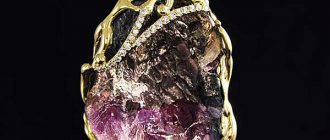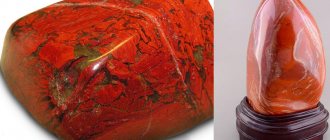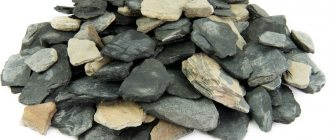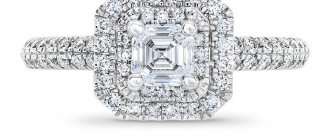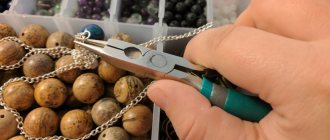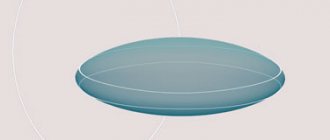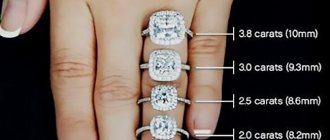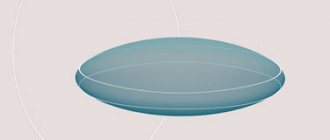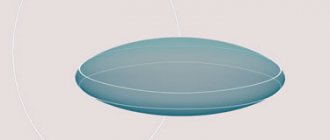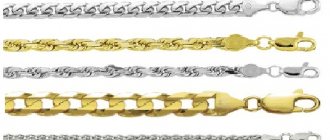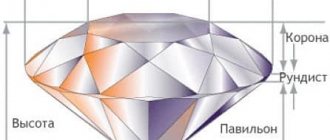Varieties of cabochon shapes
Stone cutters use several methods of finishing crystals, resulting in the following types of cabochons:
| Cabochon type | Base shape | Top shape |
| Low convex | flat | low-convex |
| Concave | distinctly concave | |
| Double | convex (slightly less) | convex (slightly larger) |
| Single | flat | distinctly convex |
After cutting, specimens of different shapes appear from the hands of professionals:
- rounded;
- oval.
Jewelers were able to create these standard forms many centuries ago. And modern craftsmen have mastered new technologies and cut out the following cabochons:
- in the form of a drop;
- rectangular;
- square;
- triangular;
- in the shape of a stylized heart;
- in the shape of an Orthodox cross;
- polygonal.
When choosing a form for processing, a professional must take into account the characteristics of the crystal. If it has an optical effect (asterism), then it is better to cut the cabochon in the shape of a circle.
And if the mineral is thin at the edges, then it is oval.
The purpose of the future accessory is also taken into account. If you plan to create a men's ring, the stone is traditionally given a cubic shape. And any variety is suitable for women’s jewelry.
Consider the natural features of the stone
The choice of cabochon type depends on the mineral. Physical properties are taken into account:
- density;
- hardness;
- shine;
- kink
For example, a dark red mineral is shaped into a cabochon. But they make it hollow.
If you make a bulge on both sides, the stone will darken even more. It will stop sparkling, the fiery reflections will disappear.
This method is used to process stones with an asterism effect—in bright light, star-shaped lines appear on the surface. They are lighter than the stone itself.
But asterism is visible only on round stones. Masters do not cut them, otherwise the mesmerizing effect will be lost.
Grinding without edges is performed on precious stones and non-natural materials. The cabochon is suitable for processing glass and plastic beads.
Also, the choice of shape depends on the type of jewelry into which the jeweler will insert the stone. Rectangular and square cabochons are more often used in men's signets and cufflinks.
Pebbles in the shape of an oval or circle are suitable for earrings, women's rings, and pendants.
Usage history
The term cabochon itself appeared around the 17th century in France. Some translators claim that the word is translated into Russian as the phrase “carnation with a hat.” And another group of philologists believes that the literal translation is “head”.
But long before the term appeared, people knew what a cabochon was.
Helpful information
This technique was used in the processing of precious and semi-precious stones in Ancient Egypt and India. However, this cut gained popularity thanks to a French statesman named Jules Mazarin.
The jewelers who worked on the stones from his collection began to use a special technique for processing crystals. It made it possible to minimize losses. After all, the craftsmen did not cut edges from natural stones, but only polished them, creating rounded specimens. Rich people liked the cabochon cut so much that they gladly began to buy jewelry with such inserts. The fashion for jewelry spread throughout Europe and was relevant until the beginning of the 20th century. At this time, technologies emerged that allowed jewelers to give precious and semi-precious stones many facets. Simply polished samples were considered ugly. Only at the end of the last century did masters remember what a cabochon was and began to widely use this technique. She remains in demand to this day. Fashionistas of all ages enjoy wearing jewelry with traditional round and oval crystals.
Cardinal Collection
Cabochon cutting initially meant only polishing the mineral. The first cabochons made from natural stones were different from modern ones. The craftsmen did not give them a specific shape, but simply smoothed out the irregularities and corners.
Then jewelers began to process stones in the form of a circle and an oval. Therefore, this form received the French name “caboche”. Translated - “head”.
According to one version, the cabochon form became widespread in Europe thanks to the French cardinal Giulio Mazarin (in French - Jules Mazarin), a church and political figure of the mid-17th century. He was famous for his collection of 18 large diamonds.
The Cardinal constantly admired the jewelry and decided to further emphasize their beauty and transparency. At his request, the jewelers processed the diamonds and gave them an oval shape.
According to another version, they learned about what a cabochon is in France before the birth of Mazarin - in the 16th century. Round stones were brought from the Indians.
However, at that time the form did not find fans. The cabochon became popular only thanks to Mazarin's love for diamonds.
This is interesting: Types of diamond cuts: examples in the photo, description and processing steps
Methods of application
Modern craftsmen use cabochons in such cases.
- Precious and semi-precious minerals are set into precious metals. Gems become inserts into earrings, brooches, pendants, men's rings, and women's rings. Recently, wide men's and women's cabochon bracelets have come into fashion.
- Ornamental stones are used to decorate wallets and women's handbags.
- Jewelry glass has become indispensable in the manufacture of costume jewelry.
Cabochons can be seen in both expensive jewelry and cheap accessories.
Properties
In order for the cabochon to acquire the best aesthetic properties and the greatest decorative value, gems with:
- unusual design;
- optical effects (asterism or iridescence);
- bright color;
- original divorces;
- multi-colored veins on the surface.
When cutting cabochons, ordinary consumers and jewelers appreciate the fact that the resulting stones are not similar to each other, with completely different patterns and shades.
Cabochon production
In past centuries, this cut was used to process the most expensive precious crystals - rubies, emeralds, sapphires, even diamonds. Jewelers used primitive tools - a special grinding wheel. The upper surface of the gem was ground and polished, while the lower surface was left in its original form. Afterwards, the ennobled crystal was inserted into a frame made of gold or silver. A more complex cutting technique appeared only towards the end of the 14th century.
Russian craftsmen used the cabochon processing technique before Peter I ascended the throne. During his reign, precious and semi-precious stones began to be processed in other ways. Only a few centuries later, cabochons came back into fashion.
Over many centuries, production technology has not changed very much.
Nowadays, jewelers do not perform actions with their hands, but use special electronic devices. The whole process obeys a certain algorithm:
- The mineral is cut into small pieces if necessary.
- The workpieces are degreased.
- Contours are applied to them using stencils.
- Excess is removed using a file or disk along the outlined contours.
- The sharp corners of the workpiece are ground on a grinding wheel.
- The upper side is made dome-shaped.
- The surfaces are ground and the top is also polished.
In the 21st century, famous designers very often use natural and artificial cabochon-cut crystals in their collections. After this treatment, the internal glow of the crystals and optical effects are revealed to the maximum.
Popularity of the cut
In Russia, back in the 18th century, jewelers understood what a cabochon was and how to process it. And in the 19th century, rounded stones became popular. They were purchased by society ladies and collectors.
But already in the twentieth century, such decorations were considered a sign of antiquity. They were worn by older ladies.
Young girls claimed that cabochons were bad manners. Bulk minerals were a sign of vulgarity.
The faceted cut has gained popularity - at least 24 facets.
Jewelers again began to massively give stones an oval shape only at the beginning of the 21st century. Retro style has come into fashion.
Designers still use cabochon jewelry in their collections. Today, this cut option remains popular in Moscow and European cities.
Secrets hidden in cabochons
In past centuries, the secrets of cabochon processing were passed on from older generations to younger ones. Nowadays they are generally known, every master can use them in his work.
- Almost any mineral can be refined in this way. But opaque and translucent samples look most impressive.
- Even relatively soft specimens (with a Mohs hardness level below 7) can be sanded perfectly.
- Optical effects (star sapphire, cat's eye) are best visible only on a convex surface.
- Sometimes cabochons are cut in a special way - the so-called “carbuncle”. The base of such a crystal is not left flat, but made concave. The result is two domes located one above the other. This is how dark transparent gems are processed.
- There is a finish that combines cabochon (top surface) and faceted crystal (bottom). The front side is given a dome shape. On the back - edges are applied.
- Large cabochons made of soft or thin crystal are reinforced with durable artificial or natural material. Most often, American jewelers do this.
- Processing in the form of a triplet (doublet) allows you to refine specimens of insufficient strength and small thickness. This method also enhances the color effects.
Knowing these rules and applying them in practice, you can create a beautiful gem.
Selection of stone for processing
Transparent minerals are rarely rounded. They sparkle and shimmer in the light due to their many facets. If you round them, the effect will disappear. It is better to make a facet cut.
But if desired, even a sparkling diamond can be rounded. Such stones were in Mazarin's collection.
Only matte stones and those that are barely visible can be completely smoothed out.
Jewelers spent a lot of time figuring out which minerals should be given a rounded shape.
Turquoise, pearls, and jadeite are optimal. Amazonite and chrysoprase are processed into cabochons.
Also suitable: star ruby, star sapphire, selenite, cat's eye, turquoise, opal, jade, agate, malachite, moonstone, agate, lapis lazuli.
There is jewelry made from transparent beads in the shape of a cabochon. But it is made of glass or plastic.
Cabochons in jewelry
Nowadays, when new materials are used everywhere, cabochon cutting is used in the processing of jewelry glass and polymer clay. Such inexpensive specimens are used to decorate teenage and youth items:
- Clutches. This fashionable addition to an evening look will emphasize the miniature details and elegance of the lady. Thanks to the clutch, your hand will look more elegant, and it will also be easier to keep track of a small handbag and protect yourself from being attacked by a thief.
- Bags. A tote bag will also fit perfectly into any look. The main thing is to match the stones with the colors of the outfit. Also an interesting idea would be a roll call of cabochons on the bag and in jewelry on the girl’s neck, ears or wrist.
- Wallets. Decorated with precious stones, they will look elegant and attractive. Such luxury will remind you of the past - of expensive handbags and handbags made of silk or satin. Moreover, it is believed that the more expensive the wallet, the more money it will save.
- Necklace. Jewelry made from cabochons will emphasize the status of a lady. It will also highlight a thin neck and shoulders and complement a plain outfit. If the stones are located vertically, they will visually make the neck thinner.
- Brooches. An unusual brooch will complement a simple or plain outfit and add individuality to a lady’s image. In the jewelry market you can find a variety of decorations in the shapes of insects, animals, flowers and much more.
- Belts. Due to the fact that the belt is decorated with precious stones, it is not embarrassing to wear it to a special event or a party. It will emphasize the silhouette and make the waist visually thinner. Moreover, such a detail of the outfit will make the girl unique and add a touch of elegance to her appearance.
Buying a finished product with cabochons will cost more than a self-made item. In order to firmly fix the stone, you need to buy special bases. To beautifully decorate minerals, bead or pearl braiding is used.
Cabochons with images of animals, portraits or plants will look especially beautiful. The stone can be decorated with a silk ribbon or made into an amulet. Such a homemade piece of jewelry will make the lady’s image unique, since such stones are an original idea of the author.
Before choosing an addition to your outfit, you need to match the colors. The cabochon must fit correctly into the image, otherwise it will look bad.
- When purchasing a stone for an evening outfit, you should give preference to bright and rich options. They will attract the attention of others, and will also look advantageous against a dark background.
- Small stones made in pastel colors. They will not stand out, but will become an important addition to the image.
- An oval cabochon is preferable for women over 45 years old.
- Girls are recommended to choose unusual cuts: heart-shaped or more interesting shapes.
- Men should take a closer look at stones with clear edges: triangles, squares, rhombuses, crosses.
Only by fully understanding what a cabochon is can you make a choice in favor of this cut. Thanks to information from history, it becomes clear where modern trends come from. And thanks to ideas about the various uses of cabochons in jewelry, you can understand which option suits a person best.
